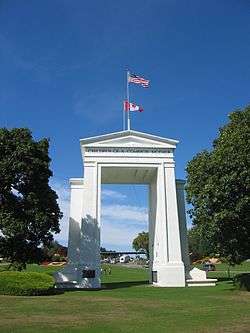Peace Arch
| Peace Arch | |
|---|---|
|
The Peace Arch from the US side. | |
| Location |
Blaine, Washington, US Surrey, British Columbia, Canada |
| Coordinates | 49°0′7.66″N 122°45′23.49″W / 49.0021278°N 122.7565250°WCoordinates: 49°0′7.66″N 122°45′23.49″W / 49.0021278°N 122.7565250°W |
| Built | 1921 |
| Architect | Harvey Wiley Corbett |
| Architectural style(s) | Classical Revival |
| Governing body | Local |
| Designated | December 13, 1996 |
| Reference no. | 96001493 [1] |
The Peace Arch is a monument situated near the westernmost point of the Canada–United States border in the contiguous United States, between the communities of Blaine, Washington and Surrey, British Columbia. The Peace Arch, which stands 20.5 metres (67 ft) tall, was built by Sam Hill and dedicated in September 1921, and commemorates the signing of the Treaty of Ghent in 1814. The monument is built on the exact United States–Canada boundary, between Interstate 5 and Highway 99, in the grass median between the northbound and southbound lanes. The Peace Arch has the flags of the US and Canada mounted on its crown, and two inscriptions on both sides of its frieze. The inscription on the US side of the Peace Arch reads "Children of a common mother", and the words on the Canadian side read "Brethren dwelling together in unity". Within the arch, each side has an iron gate mounted on either side of the border with an inscription above each gate: the one on the east side read "May these gates never be closed", while on the west side read "1814 Open One Hundred Years 1914".
Peace Arch Park consists of Peace Arch Provincial Park on the Canadian side and Peace Arch State Park on the American side of the border. Within the park is a major border crossing (between Interstate 5 on the U.S. side and British Columbia Highway 99 on the Canadian side). The Peace Arch symbolizes a long history of peace between the two nations. Because of the Peace Arch monument, the border crossing between Surrey and Blaine is popularly known as the "Peace Arch Border Crossing". In Canada, the crossing is officially named Douglas in honour of Sir James Douglas, the first governor of the Colony of British Columbia. It is one of the busiest border crossings between Canada and the United States, and the busiest such crossing west of Detroit.
The monument and surrounding park is considered an international park. As such, visitors do not require either a passport or visa to pass through their applicable border crossing so long as they stay within the boundaries of the park.[2]
History
The Peace Arch park has been the site of various international events and protests. In 1952, African-American singer and activist Paul Robeson, banned from international travel during the Red Scares, performed several concerts at the site. He sang from a flatbed truck on the American side to an audience in Canada.
One book extensively covers the history of the International Peace Arch. It bears the title, Sam Hill's Peace Arch: Remembrance of Dreams Past by Richard Clark (2005).
On 9 February 2010, the Vancouver 2010 Olympic Torch Relay visited the Peace Arch.
Gallery
See also
Notes
- ↑ National Park Service (2007-01-23). "National Register Information System". National Register of Historic Places. National Park Service.
- ↑ About Peace Arch Park
External links
| Wikimedia Commons has media related to Peace Arch. |



